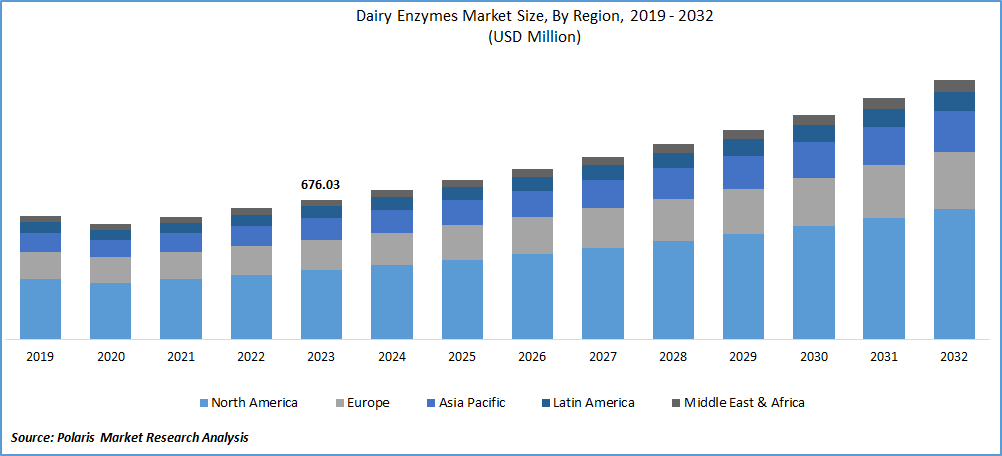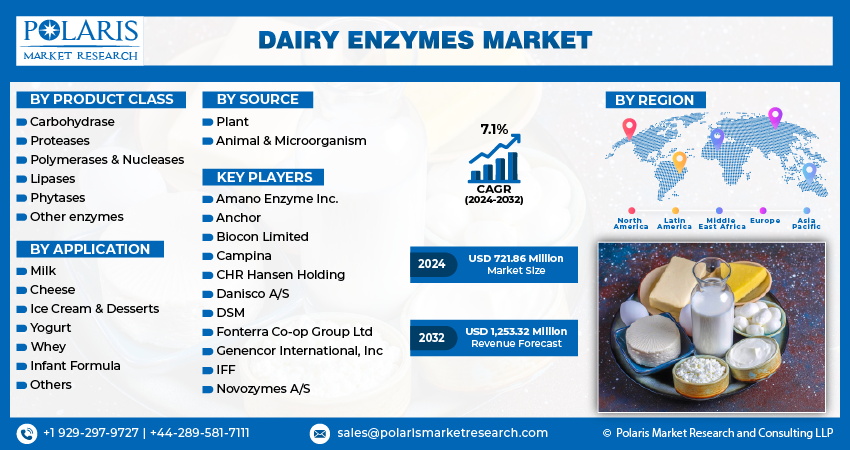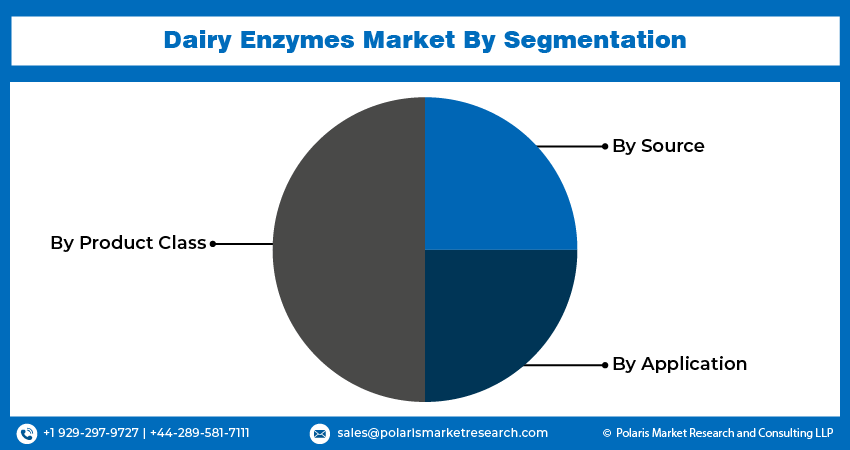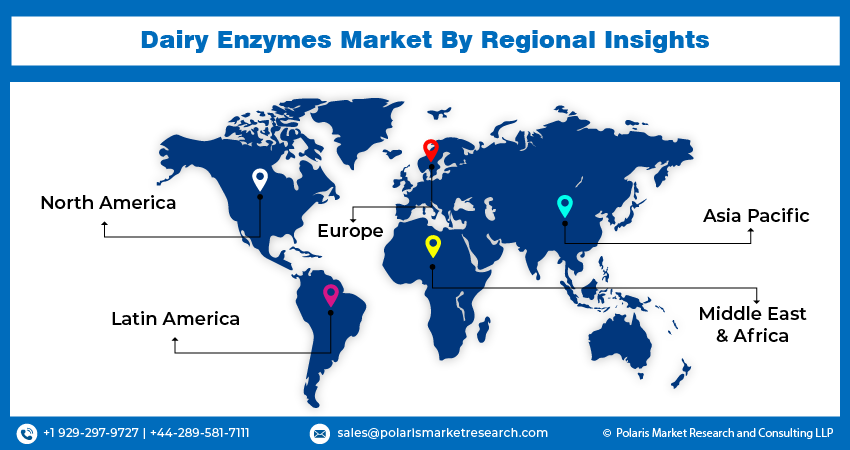
Dairy Enzymes Market Share, Size, Trends, Industry Analysis Report, By Product Class (Carbohydrases, Proteases, Polymerases & Nucleases, Lipases, Phytases, Other enzymes); By Source; By Application; By Region; Segment Forecast, 2024 - 2032
- Published Date:Feb-2024
- Pages: 117
- Format: PDF
- Report ID: PM1716
- Base Year: 2023
- Historical Data: 2019-2022
Report Outlook
The global dairy enzymes market was valued at USD 676.03 million in 2023 and is expected to grow at a CAGR of 7.1% during the forecast period.
Dairy enzymes are specialized proteins that play a crucial role in the production and processing of dairy products. These enzymes function as catalysts, promoting biochemical reactions that transform various components in milk into different products. The three types of dairy enzymes are microbial enzymes derived from microorganisms like bacteria or fungi, animal-derived enzymes, and plant-derived enzymes. The application of these enzymes in the dairy industry enhances production efficiency, improves product quality, and introduces innovations in dairy processing techniques.
The market is witnessing significant growth due to increasing consumer demand for dairy products with improved nutritional profiles. Enzymes play a crucial role in facilitating processes such as lactose breakdown, which is essential for consumers with lactose intolerance, broadening the market demand for dairy products. Advancements in biotechnology and enzyme engineering positively impact the dairy enzymes market. Manufacturers are investing in research and development activities to enhance the efficiency and specificity of enzymes, resulting in improved production processes and cost-effectiveness for the dairy industry. This technological progress not only increases the overall efficiency of dairy enzyme applications but also opens up opportunities for innovation in product development.

To Understand More About this Research: Request a Free Sample Report
However, the market faces certain restraining factors, such as the stringent regulatory landscape governing enzyme applications in the food and dairy industry. Compliance with various regional regulations and standards creates complexities for market players, influencing the adoption of dairy enzymes. Concerns related to the sourcing of enzymes and their production processes are becoming increasingly a point of focus, impacting consumer perceptions and purchasing decisions.
The Dairy enzymes market report details key market dynamics to help industry players align their business strategies with current and future trends. It examines technological advances and breakthroughs in the industry and their impact on the market presence. Furthermore, a detailed regional analysis of the industry at the local, national, and global levels has been provided.
Growth Drivers
- Continuous innovations in dairy technology drive market growth.
Technological advancements in the dairy industry have led to the development of more efficient processes for incorporating enzymes into various stages of production. Innovations such as the improvement of enzymatic solutions that serve specific functionalities, like lactose hydrolysis, curd formation, and flavor enhancement. These advancements add to optimizing the overall efficiency of dairy processing, enabling manufacturers to produce high-quality products with improved taste, texture, and nutritional profiles.
Also, the incorporation of biotechnology and enzyme engineering has played an important role in enhancing the performance of dairy enzymes. Through genetic modification and advanced screening techniques, researchers have been able to alter enzymes to meet the rising demands of dairy products. Continuous innovations also create the need for the exploration of new sources for producing enzymes. The industry is increasingly adopting eco-friendly practices by exploring new sources, including microbial fermentation and plant-based enzyme production. Owing to these innovations in dairy enzymes, the market is continuously growing at a significant growth rate.

Report Segmentation
The market is primarily segmented based on product class, source, application, and region.
|
By Product Class |
By Source |
By Application |
By Region |
|
|
|
|
To Understand the Scope of this Report: Speak to Analyst
By Product Class Analysis
- The carbohydrase segment dominated the market in 2023
In 2023, the carbohydrase segment emerged as a dominant segment in the global market. Carbohydrase, a category of enzymes that catalyze the breakdown of carbohydrates into simpler sugars, plays an important role in various stages of dairy processing. The primary application of carbohydrase in the dairy industry is in lactose hydrolysis, where enzymes such as lactase break down lactose into more easily digestible sugars like glucose and galactose. This process is significant in meeting the needs of consumers with lactose intolerance and broadening the market reach of dairy products. The carbohydrase segment dominates due to ingredients like amylase, which offer simplified optimization and modification processes and high cost-effectiveness.
By Application Analysis
- The cheese segment accounted for the largest revenue share in 2023.
The cheese segment accounted for the largest revenue share because of the important role that enzymes play in the process of cheese production. Enzymes are necessary for coagulating milk proteins, leading to the formation of curds, a fundamental step in cheese making. Enzymes such as lipase contribute to the breakdown of fats, generating unique flavors that define different types of cheeses.
The cheese industry's reliance on enzymes is beyond traditional processes, as advancements in enzyme technology have allowed manufacturers to enhance production efficiency and alter cheese characteristics to meet market demands. The popularity of cheese as a multipurpose and globally consumed dairy product has resulted in consistent demand for dairy enzymes in this segment.

Regional Insights
- North America is the largest revenue contributor and holds the major market share in 2023.
The growth of the North American market is primarily due to the high level of awareness among people about healthy diets and dietary supplements. Moreover, there is a significant demand for dairy enzymes among people who are looking for highly specific food products. Also, the presence of major industry players in the U.S., the robust awareness of dietary supplements, and the substantial demand for dairy enzymes from dairy product manufacturers are expected to drive the growth of the North American market. The strong distribution channel is further augmenting the market growth in the North American region. Furthermore, the North American dairy enzymes market is driven by the early adoption of advanced technology in dairy industries and the introduction of new enzymes. This market also experiences growth due to the increase in the number of dairy processing industries in the region.
The Asia-Pacific region is expected to have significant growth because of the convenience of dairy products. For example, yogurt drinks are becoming increasingly popular in the Asia-Pacific region due to their convenience. This trend is expected to bridge the gap in yogurt consumption that has been created in recent years. The growing presence of drinkable yogurts is seen as a positive development that will help to boost the overall consumption of yogurt. The region is experiencing an increasing demand for dairy products because of the rising population, increasing disposable incomes, and emerging dietary preferences. The dairy industry in the Asia Pacific is undergoing a transformative phase with a focus on modernization and technological advancements. Dairy enzymes play a pivotal role in meeting the demands of customers by fostering processes such as lactose hydrolysis for lactose-intolerant consumers.

Key Market Players & Competitive Insights.
Major players in the market are mainly concentrating on innovation, product development, and strategic acquisitions to enhance their capabilities for research and development of new products. These key strategies help companies to strengthen their position in the market while also expanding their geographical reach.
Some of the major players operating in the global market include:
- Amano Enzyme Inc.
- Anchor
- Biocon Limited
- Campina
- CHR Hansen Holding
- Danisco A/S
- DSM
- Fonterra Co-op Group Ltd
- Genencor International, Inc
- IFF
- Novozymes A/S
Recent Developments
- In May 2023, DSM, a nutrition, health, and beauty products company, launched Maxilact Next, a pure lactase enzyme for more efficient lactose-free dairy production.
- In June 2021, International Flavors & Fragrances Inc. (IFF) launched Nurica, which is an enzyme for dairy products.
Dairy Enzymes Market Report Scope
|
Report Attributes |
Details |
|
Market size value in 2024 |
USD 721.86 million |
|
Revenue Forecast in 2032 |
USD 1,253.32 million |
|
CAGR |
7.1% from 2024 – 2032 |
|
Base year |
2023 |
|
Historical data |
2019 – 2022 |
|
Forecast period |
2024 – 2032 |
|
Quantitative units |
Revenue in USD million and CAGR from 2024 to 2032 |
|
Segments Covered |
By Product Class, By Source, By Application, By Region |
|
Regional scope |
North America, Europe, Asia Pacific, Latin America, Middle East & Africa |
|
Customization |
Report customization as per your requirements concerning countries, regions, and segmentation. |
We provide our clients the option to personalize the Dairy enzymes market report to suit their needs. By customizing the report, you can get data as per your format and definition. Also, the customization option allows you to gain a deeper dive into a specific segment, region, customer, or market competitor.
FAQ's
Dairy Enzymes Market report covering key segments are product class, source, application, and region.
Dairy Enzymes Market Size Worth USD 1,253.32 Million By 2032
The global dairy enzymes market is expected to grow at a CAGR of 7.1% during the forecast period.
North America is leading the global market.
The key driving factors in Dairy Enzymes Market are Increasing consumer demand for dairy products with improved nutritional profiles
